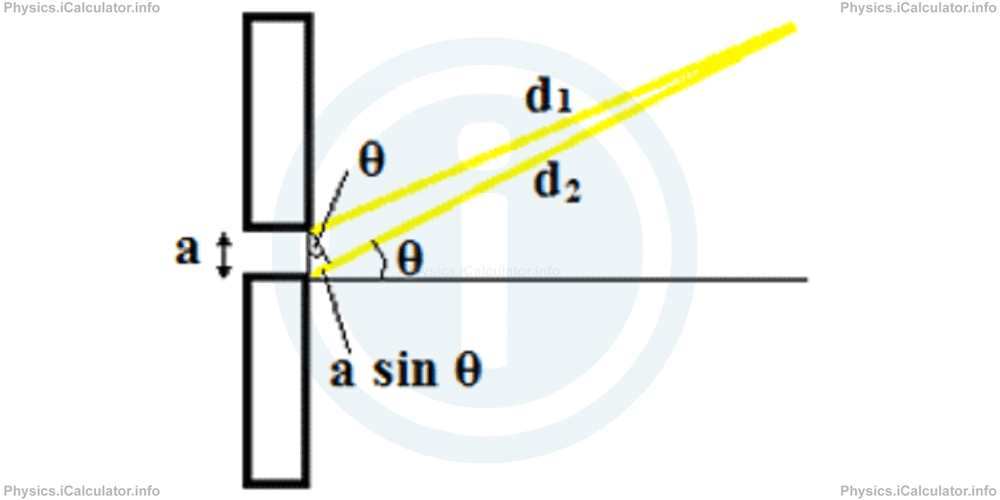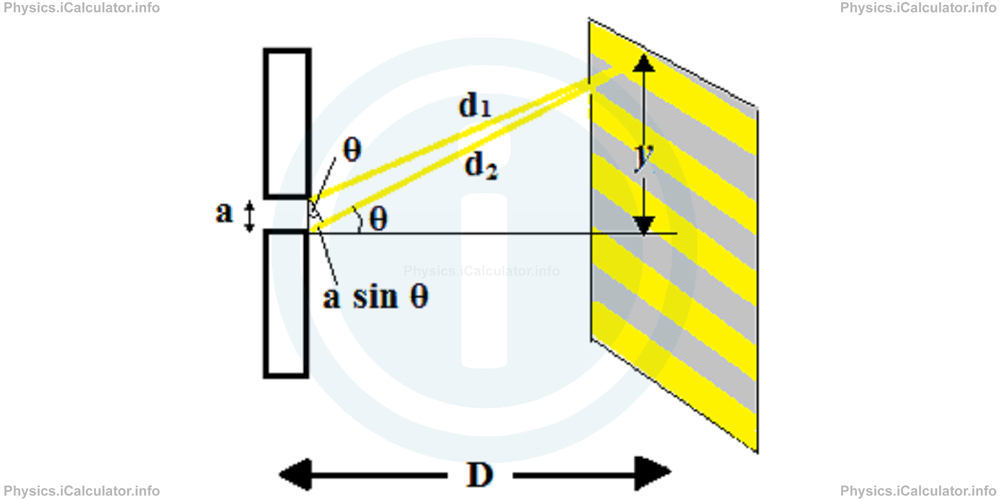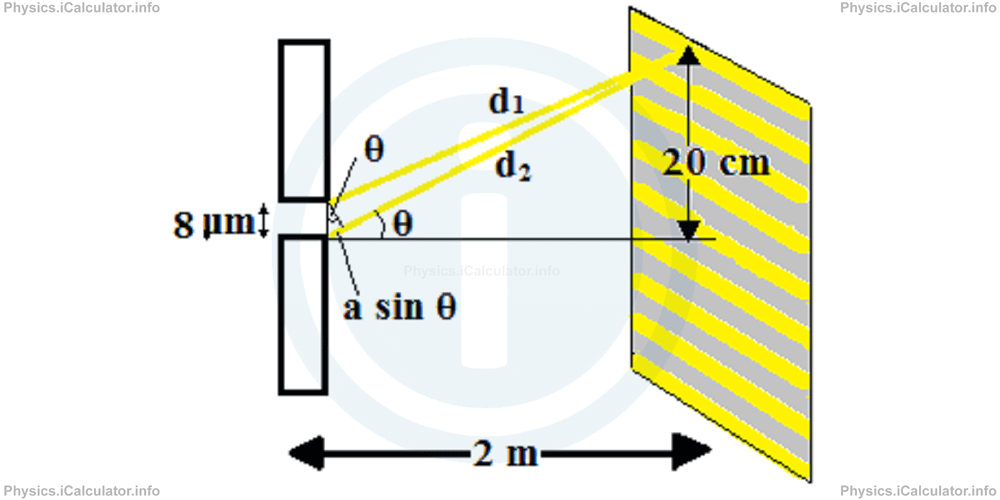Menu
Physics Lesson 12.4.2 - Single Slit Diffraction Formula
Please provide a rating, it takes seconds and helps us to keep this resource free for all to use
Welcome to our Physics lesson on Single Slit Diffraction Formula, this is the second lesson of our suite of physics lessons covering the topic of Interference and Diffraction of Light, you can find links to the other lessons within this tutorial and access additional physics learning resources below this lesson.
Single Slit Diffraction Formula
As explained in the Interference of Waves, the path difference between the two waves after passing through the slit must be a whole multiple of wavelength in order to observe a constructive interference (bright region) or a half multiple of wavelength for destructive interference (dark region). The equations for each case are:
for bright regions (constructive interference) and
for dark regions (destructive interference), where N is an integer.
The above equations represent the conditions for the interference to occur in single slit diffraction.
Now, let's consider the following figure.

The path difference d2 - d1 represents the opposite side of the angle θ in the small right triangle in the figure, where the hypotenuse is the slit's width a. This means the path difference d2 - d1 is equal to a × sin θ where θ is the angle formed by the rays' direction and the horizontal direction (in reality we consider the small angle inside the triangle which is equal to θ as well (because angles with perpendicular corresponding sides are equal). Therefore, we obtain the equation of single slit diffraction:
This equation helps us determine the wavelength if we know the slit's width and the angle formed by the rays to the horizontal direction, because we have
for constructive interference and
for destructive interference.
At this point, the drawback is the number N that gives the multiple of wavelength in the path difference, which is impossible to know in these conditions. Therefore, we use the triangles' similarity rules to find indirectly the number N of extra wavelengths of the longest ray because the number of wavelengths caused by this difference in light paths causes a number of bright and dark strips on the screen.
In other words, the difference in light paths
brings as a result a displacement y of the point in which the rays converge which is the same multiple of the thickness of a pair of strips (one bright and one dark. Look at the figure.

From the triangles similarity rules we have:
Given that
and
we obtain
Hence,
However, it is not necessary to use such a long approach to find the number of extra cycles N travelled by the wave of the longest path as this number can be obtained by counting the strips. This is because the screen acts like a projector or a magnifier, so the number of strips corresponds to the number of extra waves. Therefore, it is enough the equation
for constructive interference and
for destructive interference to find the wavelength λ which is the ultimate goal in these situation.
Example 1
A light beam containing two coherent and unicolour light waves, passes through a 0.4 μm thin slit and forms the 5-th maximum 2 cm above the central maximum on a screen that is placed 2 m away from the slit. What is the wavelength of these light waves?

Solution 1
In this problem we have the following clues:
a = 8 μm = 8 × 10 - 6 m
y = 20 cm = 2 × 10 - 1 m
λ = ?
First, let's determine the angle θ. From the figure, we can see that
= 20 cm/2m
= 20 cm/200 cm
= 0.1
Therefore,
=5.710
Now, since we have a maximum in the given point of the screen, we use the equation
to determine the wavelength λ. Thus, substituting the known values, we obtain
8 × 10-6 × 0.01 = 5 × λ
8 × 10-8 = 5 × λ
λ = 8 × 10-8/5 m
= 1.6 ×10-8 m
As you see from the result, these light rays belong to UV spectrum.
You have reached the end of Physics lesson 12.4.2 Single Slit Diffraction Formula. There are 4 lessons in this physics tutorial covering Interference and Diffraction of Light, you can access all the lessons from this tutorial below.
More Interference and Diffraction of Light Lessons and Learning Resources
Whats next?
Enjoy the "Single Slit Diffraction Formula" physics lesson? People who liked the "Interference and Diffraction of Light lesson found the following resources useful:
- Single Slit Feedback. Helps other - Leave a rating for this single slit (see below)
- Optics Physics tutorial: Interference and Diffraction of Light. Read the Interference and Diffraction of Light physics tutorial and build your physics knowledge of Optics
- Optics Revision Notes: Interference and Diffraction of Light. Print the notes so you can revise the key points covered in the physics tutorial for Interference and Diffraction of Light
- Optics Practice Questions: Interference and Diffraction of Light. Test and improve your knowledge of Interference and Diffraction of Light with example questins and answers
- Check your calculations for Optics questions with our excellent Optics calculators which contain full equations and calculations clearly displayed line by line. See the Optics Calculators by iCalculator™ below.
- Continuing learning optics - read our next physics tutorial: Dispersion of Light
Help others Learning Physics just like you
Please provide a rating, it takes seconds and helps us to keep this resource free for all to use
We hope you found this Physics lesson "Interference and Diffraction of Light" useful. If you did it would be great if you could spare the time to rate this physics lesson (simply click on the number of stars that match your assessment of this physics learning aide) and/or share on social media, this helps us identify popular tutorials and calculators and expand our free learning resources to support our users around the world have free access to expand their knowledge of physics and other disciplines.